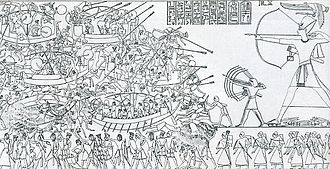Mga Taong Dagat

Ang Mga Taong Dagat ay konpederasyon ng mga mandaragat na sumalakay sa Sinaunang Ehipto at ibang mga rehiyon sa Silanang Mediteraneo bago at noong huling Pagguho ng Panahong Tanso (1200–900 BCE).[1][2] Ang pangyayaring ito ang pinakilalang kabanata sa kasaysayan ng Ehipto.[3][4]
Isa din silang marahas na mandaragat na sumakop sa mga bansa sa Sinaunang Malapit na Silangan sa Anatolia, Syria, Palestina at Sinaunang Ehipto hanggang sa wakas ng Panahong Bronse (ika-13 siglo BCE). Sila ang responsable sa pagbagsak ng mga matatandang kapangyarihan sa rehiyon gaya ng Imperyong Hiteo. Ang mga ebidensiya sa pag-iral ng Mga taong Dagat ay mula sa mga sangguniang Ehipsiyo, mga Hiteo at arkeolohiya. Ang mga Sinaunang Ehipsiyo ay nakipagdigma sa Mga Taong Dagat noong ika-5 taon ni Paraon Merneptah at ni Ramesses III.[5]
Tingnan din
[baguhin | baguhin ang wikitext]Mga sanggunian
[baguhin | baguhin ang wikitext]- ↑ Killebrew 2013, p. 2. Quote: "First coined in 1881 by the French Egyptologist G. Maspero (1896), the somewhat misleading term 'Sea Peoples' encompasses the ethnonyms Lukka, Sherden, Shekelesh, Teresh, Eqwesh, Denyen, Sikil / Tjekker, Weshesh, and Peleset (Philistines). [Footnote: The modern term 'Sea Peoples' refers to peoples that appear in several New Kingdom Egyptian texts as originating from 'islands' (tables 1–2; Adams and Cohen, this volume; see, e.g., Drews 1993, 57 for a summary). The use of quotation marks in association with the term 'Sea Peoples' in our title is intended to draw attention to the prtic nature of this commonly used term. It is noteworthy that the designation 'of the sea' appears only in relation to the Sherden, Shekelesh and Eqwesh. Subsequently, this term was applied somewhat indiscriminately to several additional ethnonyms, including the Philistines, who are portrayed in their earliest appearance as invaders from the north during the reigns of Merenptah and Ramesses Ill (see, e.g., Sandars 1978; Redford 1992, 243, n. 14; for a recent review of the primary and secondary literature, see Woudhuizen 2006). Henceforth the term Sea Peoples will appear without quotation marks.]"
- ↑ Drews 1995, pp. 48–61: "The thesis that a great 'migration of the Sea Peoples' occurred ca. 1200 B.C. is supposedly based on Egyptian inscriptions, one from the reign of Merneptah and another from the reign of Ramesses III. Yet in the inscriptions themselves, such a migration nowhere appears. After reviewing what the Egyptian texts have to say about 'the sea peoples', one Egyptologist (Wolfganga [[Sinaunang Helck) recently remarked that although some things are unclear, 'eins ist aber sicher: Nach den ägyptischen Texten haben wir es nicht mit einer "Völkerwanderung" zu tun' ['One thing is however certain: according to the Egyptian texts we are not dealing with a "migration"'] Thus the migration hypothesis is based not on the inscriptions themselves but on their interpretation".
- ↑ Müller 1888, p. 147: "In Egyptian history, there is hardly any incident of so great an interest as the invasion of Egypt by the Mediterranean peoples, the facts of which are connected with the most important questions of ethnography and the primitive history of classic nations."
- ↑ Hall 1922.
- ↑ https://www.britannica.com/topic/Sea-People
